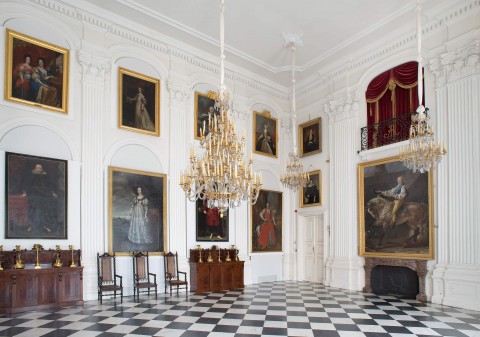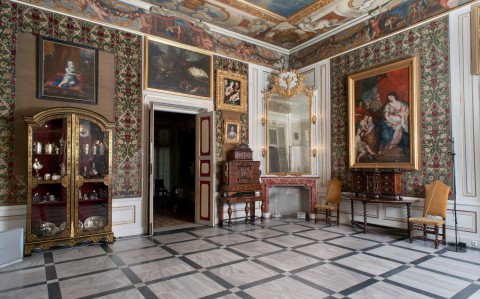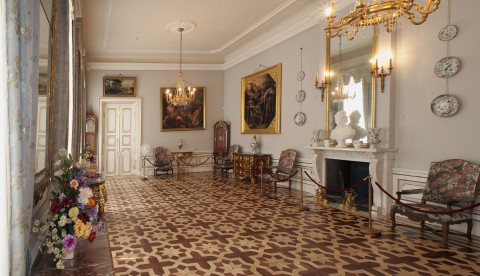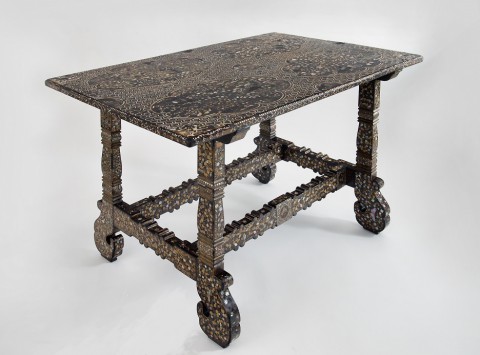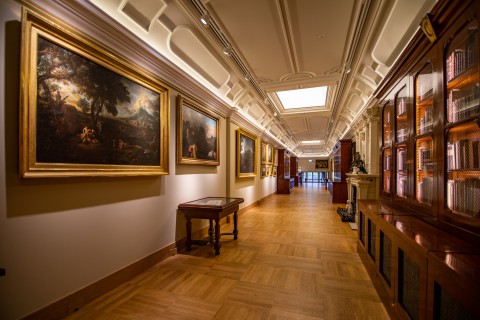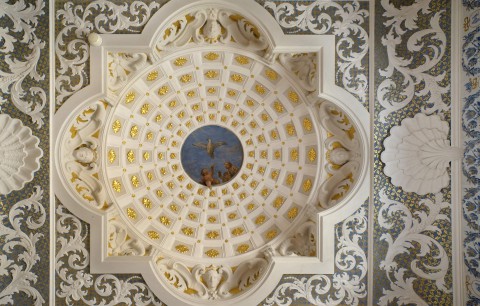Brief descriptions of the interiors in the Wilanów Palace
The Wilanów Palace is open for visitors – check opening times here.
First Floor
The White Hall
Around 1730, when the Wilanów estate was leased by King Augustus II the Strong of the Wettin dynasty, a representative White Hall was established. This largest and most magnificent room in the palace has witnessed many important ceremonies. Today, its décor recalls primarily the shape of the hall in the 19th c. Collected here are paintings of subsequent owners of the palace (including King Jan III Sobieski) or persons associated with it. The magnificent Equestrian Portrait of Stanisław Kostka Potocki by Jacques-Louis David is one of the most valuable works of art in the Polish collection.
The Equestrian Statue of King Jan III and The South Gallery
The Equestrian Statue of King Jan III was produced around 1693, to commemorate the 10th anniversary of the victorious Battle of Vienna. It had originally stood in the Grand Vestibule and was moved to its current location in the 1720s. The South Gallery initially opened to the garden. Its decorations include exquisite frescoes by Florentine artist Michelangelo Palloni, depicting the amorous tribulations of Cupid and Psyche. The story reflects the affection that united Jan Sobieski and Marie Casimire. In the original design, a small room, now a Lapidarium (room with antiquities), was part of the South Gallery, which is why the first scene from the mythological story can be found on this ceiling.
The King’s Library
Initially, the King’s Library housed a rich collection of the monarch’s books, later moved to his family estate in Żółkiew (now Zhovkva, Ukraine). A subject catalogue of the collection has been preserved to this day, located on the ceiling and partially on the walls. It consists of medallion portraits of the most famous artists and thinkers of the ancient and early modern times. Below each of them, a bookcase stood with books that corresponded to the discipline pertaining to the person portrayed above. Of note is also the three-coloured marble floor, creating a visual illusion. This is the only floor in the palace that dates back to the time of King Jan III! The Chapel, adjacent to the King’s Library, was erected in mid-19th c. to commemorate the place where King Jan III died in 1696.
The King’s Antechamber and The King’s Bedroom
The Antechamber served as a representative hall, where courtiers waited for an audience with the King. In accordance with Baroque customs, such meetings were often held in camera, i.e. in the King’s Bedroom. During the audience, the King would lie in a ceremonial bed while the visitors remained standing. Only the closest family and the most distinguished guests were permitted to sit in the company of the ruler. The preserved decorations of the ceilings of the Antechamber and the King’s Bedroom are among the most valuable examples of Baroque art in Poland. The plafond paintings – Winter (Antechamber) and Summer (Bedroom) – were made by Jan III’s court painter – Jerzy Eleuter Szymonowicz-Siemiginowski.
The Grand Vestibule and Equestrian Monument to Jan III
During the reign of Jan III, the Grand Vestibule was one of the most representative and monumental rooms in the palace. For many years it served as a dining room – in those days, its decorations were richer, but did not survive in their entirety to this day. Currently, visitors can admire the ceiling stucco decoration of the coving that shows the four elements and the four mythological winds. Across from the main entrance to the palace, in a niche between the columns, the equestrian statue of Jan III once stood – one of the many elements of glorification of the great victor of the Battle of Vienna. At present, the monument is located near the south tower, at the entrance to the gallery.
The Queen’s Antechamber and The Queen’s Bedroom
The layout of the queen’s room is a symmetrical reflection of the king’s apartments: the Antechamber served as a vestibule, while the Bedroom (Chamber), in addition to its basic function, had a representative character. The Queen’s Bedroom is undoubtedly one of the most impressive rooms in the palace. Particularly noteworthy is the ceiling painting (plafond) depicting an allegory of Spring, painted by Jerzy Eleuter Szymonowicz-Siemiginowski. The figure of the goddess Flora portrayed in the plafond is based on Queen Marie Casimire. In the Antechamber, the plafond painting represents Autumn, completing the series of the four seasons.
The Al Fresco Cabinet
The Al Fresco Cabinet is decorated with original 17th-century wall paintings imitating stone portals and draped wall tapestries with mythological scenes featuring Apollo. The decoration was uncovered by conservators in 1955 – prior to this, a wooden staircase leading to the upper palace level was located here.
The Princess Marshal Lubomirska’s Apartments – Anteroom
Izabela Lubomirska née Czartoryska (1736–1816) owned Wilanów between 1771 and 1799. She was a great lover of art. The surviving rooms in the southern wing of the palace perfectly illustrate her taste. English mirrors from ca. 1730 were hung between the windows. The furnishings in the Anteroom are complemented with upholstered furniture from the Aubusson manufacture in France, secretary desks from the early 18th c., and a masonry heater from the manor house in Pruszków. The interior is decorated with portraits of Izabela, her four daughters, her parents, and her two sons-in-law: brothers Ignacy Potocki and Stanisław Kostka Potocki.
The Princess Marshal Lubomirska’s Apartments – Parlour
The room’s furnishings consist of a chest of drawers with gilded bronze fittings, upholstered French armchairs from the 1st quarter of the 18th c., three English mirrors from ca. 1720, and porcelain vases decorated with flowers, made in 1730–1760 in Meissen. Far-Eastern plates and bowls have been hung around the fireplace. On the walls, you can admire paintings from the collection of Stanisław Kostka Potocki, Izabela’s son-in-law: Apotheosis of a Venetian senator (circle of Jacopo Robusti called Tintoretto), and Park Scene by François Watteau. Of note is the portrait of Elżbieta Sieniawska (1669–1729) – owner of the Wilanów palace in 1720–1729 and Izabela Lubomirska’s grandmother.
Upper Floor
On the upper floor of the Wilanów Palace, you can currently see excellent paintings, sculptures and other art objects from the collection initiated by Stanisław Kostka and Aleksandra Potocki – incl. the famous ‘Salvator Mundi’ (‘Savior of the World’) – once considered the work of Leonardo da Vinci himself.
The Wilanów collection, made available to the public in 1805, is the product of a well-thought-out and consistently built collecting concept, which was made a reality in suitable surroundings, with respect to the genius loci of the historic royal residence. For its creation, the collection required not only material means, but also intellectual, emotional and knowledge capital.
Former Chinese Rooms of Stanisław Kostka Potocki
The Wilanów oriental art collection dates back to the late 17th c. and the times of the first owner of the Palace, King Jan III. Subsequent palace inhabitants also had a soft spot for the Orient. The current arrangement draws on the interior and the furnishings of the former Chinese Rooms fitted out by Stanisław Kostka Potocki on the upper floor of the Palace’s main body in the first quarter of the 19th c. Artefacts from the historical collection – ceramics, ivory wares and enamels – have found their way to the contemporary display case modelled after the glass-door cabinet dating to the early 19th c., which stands in the neighbouring Chinese Room. The exhibition is complete with two original cabinets decorated with Chinese lacquer. These items of furniture also belonged to the initial 19th-c. interior of the Chinese apartment.
Nanban table
The unique Nanban table, made in 17th c. in Japan, merits special attention: it is decorated with lacquer, mother of pearl, gold, and silver, and is the largest of the few known to exist across the globe. Conservation of this unusual artefact consumed two years and considerable efforts. The project was co-financed by the Polish Minister of Culture and National Heritage, and the Japanese Sumitomo Foundation. For conservation-related reasons, we placed the table in a special display case with reduced lighting and a stable climate. Try the state-of-the-art multimedia station to take a closer look at enlarged table details.
Chinese Room with coffers
This room’s oriental-patterned wallpaper is a reconstruction. Images of dragons decorate the coffered ceiling. The interior is equipped with oriental-style furniture – both Chinese and European. The alcove's glass-door cases accommodate some objects from the porcelain, enamel and small handicraft collections containing original Far Eastern items and oriental imitations. The large Imari vases are a highlight of this room. Their characteristic multi-coloured decorations combine golden, red and cobalt blue elements.
Chinese Room with watercolours
This room gets its name from the oriental genre scenes painted on the walls. The red secretary desk between the windows dates as far back as the times of Augustus II. Stanisław Kostka Potocki had the escritoire redone, and its drawers became part of the desk standing at the centre of the room. The internal panels of a different piece of Saxon furniture, the cabinet, became the doors of the low cupboard. These parsimonious efforts helped produce a new set of furniture decorated with a European technique imitating precious oriental lacquer.
Hunting Room I
The Wilanów Palace has two Hunting Rooms. Their walls are covered with polychrome faux bois. The faux bois (French for ‘false wood’) or woodgraining technique uses paint to mimic the appearance and texture of different tree species. The first room presents European furniture which reflects the Old Continent’s fascination with Far Eastern art. The oriental lacquer on the two commodes and desk comes from Asia. After oriental wares reached Europe, the lacquer was taken off and placed on European-shaped furniture. In contrast, the two cabinets sitting on console tables are purely European and only imitate Far Eastern forms of art.
Hunting Room II
In the second half of the 19th c., this room served as the study of August Potocki, the owner of the Wilanów Palace. Like most men of his times, August Potocki frequently entertained himself by hunting. Although the artwork and objects presented in this room hail from different eras, they all share the motif of hunting.
The Storage Accessible for Visitors
The Storage Accessible for Visitors is an exhibition space created in the Markoniówka – a three-storey building adjacent to the south wing of the palace. The unique character of the exhibition of the Storage Accesible for Visitors allows for the presentation of valuable works of art, which for many reasons have not been shown for years. It houses an exclusive collection of goldsmiths’ goods, original wall fabrics from royal apartment and a collection of objects from the Far East, including works decorated with several types of lacquer, enamelled metal dishes, a rich collection of porcelain, as well as water-colour paintings on paper.
Potocki Collection Gallery
Within the new exhibition, we present masterpieces of the Wilanów collection. The show on the first floor is a continuation of the motifs present on the ground floor of the palace. As early as 1805, the palace housed the museum of King Jan III, created and made available by Aleksandra and Stanisław Kostka Potocki. After their deaths, the collecting traditions were continued by their son Aleksander, followed by his grandson August and his wife Aleksandra Potocki née Potocka. They contributed not only to the expansion of the collection, but also to the popularisation of the Wilanów residence.
The Quiet Room
The Quiet Room is located exactly over the King’s Bedroom. It is one of a few rooms in the Palace that still contains original decorations dating back to the times of King Jan III. They are believed to be the work of two painters: Jerzy Eleuter Szymonowicz-Siemiginowski, the author of the allegorical plafonds on the four seasons in the royal apartments, and Michelangelo Palloni, who painted the story of Amor and Psyche in the South and North Galleries. The ceiling of the Quiet Room features a trompe l’oeil illusion of a cupola with goddess Venus at the centre, surrounded by symbols representing the components of the fine arts: nature, imitation, idea and practice, knowledge, imagination, and ingenuity. The image of the eagle symbolises the King’s patronage of the arts, but the significance of other figures in the painting remains unclear. The walls of this room are adorned with landscapes and views of lush gardens bounded by colonnades.
Faience Cabinet
The Faience Cabinet owes its name to the faience tiles that cover its walls. The tiles, numbering roughly 1956, were made around 1690 in workshops in Amsterdam and Utrecht. During the Baroque period, this type of decoration was particularly valuable and fashionable, and it is often found in European magnate courts. The tiles are decorated with courtly, pastoral, or biblical scenes, motifs of horse-riding, depictions of unusual sea creatures, and landscapes. They provide a frame for 122 panels, composed in most cases of 12 tiles, depicting vases with floral bouquets; the gilding was added later, once the tiles were already on the wall. The presence of so many flowery panneaux, half of which include unique chinoiserie-style embellishments, contributes to an interior of uncommon beauty, exceptional even among other undertakings of its kind in Europe. Furthermore, the set of tiles surviving in the cabinet includes nearly all of the patterns then in use in Utrecht. Together with the adjacent Three Windows Cabinet, the Faience Cabinet was designed for everyday use. Its ceiling is adorned with an illusionist fresco – a cupola with coffers and the image of a little putto whose leg emerges from the wall. These eye-teasing combinations of painting and sculpture were a characteristic feature of Baroque art.
Temporarily closed rooms
The Cabinet before the Gallery
Stanisław Kostka Potocki – politician, collector and archaeologist, sometimes referred to as the Polish Winckelmann – was the owner of Wilanów in 1799–1821. In 1805, he made his art collection, accumulated at the palace in Wilanów, available to the public. Thus was created the first art museum available to everyone in Poland. The small Cabinet before the Gallery contains European paintings from the collection of Stanisław Kostka Potocki. Embedded in the threshold of the room is a plaque with a Latin inscription: Cunctis patet ingressus (entrance free for all), a testament to the merits of the founder of the museum laid by his grandson, August Potocki.
The North Gallery and The Etruscan Cabinet
The North Gallery originally opened to the garden. Its decorations include exquisite frescoes by Florentine artist Michelangelo Palloni, depicting the amorous tribulations of Cupid and Psyche. The story reflects the affection that united Jan Sobieski and Marie Casimire. In 19th c., the North Gallery was adapted for displaying paintings, sculpture, and artistic crafts. As was the case with the Lapidarium, the Etruscan Cabinet was used to display the collection of antiquities gathered by the Potocki family. Presently, there are over 100 antique vases here, from southern Italy, Etruria, and Athens.
The Painting Gallery called the Museum and The Lanscape Gallery
The Painting Gallery called the Museum and the Landscape Gallery were adapted into a pinacotheca presenting Italian, French, Flemish, and German paintings. The walls were painted Pompeii pink, a colour often used in 19th-century museum interiors because it provided an excellent background for the paintings on display. The rich collection of paintings at the palace included works of Lucas Cranach, Jan Lievens, Eustache le Sueur, and Angelika Kauffmann (in the Raspberry Parlour), among others. Of particular interest is the monumental (over 4 meters long) painting depicting the ceremonial entrance of Michał Kazimierz Radziwiłł, envoy of King Jan III, to Rome in 1680.
The Lower Vestibule
The artistic décor of the apartments in the North Wing, commissioned by Sieniawska in the 1720s, was essentially limited to ceilings and covings. The plafond in the elliptical dome covering the hallway of the North Wing (the Lower Vestibule) shows Elżbieta Sieniawska as goddess Flora surrounded by putti.
The Cabinets of Antiquities
The current presentation of the consolidated collection of ancient vases and Egyptian collections allows us to see them how Stanisław Kostka Potocki intended – in the historical interiors of the palace, inside historical wardrobes, and against the backdrop of the restored set decorations. In the 19th c., the collection was a source of knowledge about European art and shaped the aesthetic sensitivity of Poles, a people deprived of their own country. Subsequent generations of palace owners ensured the preservation of its unique character, and Stanisław Kostka’s grandson, August Potocki, and his wife, Aleksandra, significantly expanded the antiquities collection in the 2nd half of the 19th c.
The Princess Marshal Lubomirska’s Apartments – Golden Bedroom
In the times of Izabela Lubomirska, the walls of the Golden Bedroom were decorated with paper coverings imported from England, adorned with floral ornaments, Chinese motifs, and arabesques, which were fashionable during the 18th c. The bed of the Princess Marshal and the set of five armchairs were made by a local carpentry workshop at the end of the 18th c. Presented on a round table are dishes for drinking chocolate and storing tea leaves. The interior is decorated also with unglazed bisque figures, made of Meissen porcelain. The handicraft table standing near the window is a gift to Izabela from Marie-Thérèse Charlotte of France (1778–1851), daughter of King Louis XVI (1754–1793).
The Princess Marshal Lubomirska’s Apartments – Study
The Bathing Pavilion, the first room of which is the Study, was built in 1775–1778 according to a design by Simon Gottlieb Zug (1733–1806). At the door between the Golden Bedroom and the Study, attention is drawn by an optical zograscope from the 2nd half of the 18th c. or early 19th c. When looking at purposely-made prints through the lens mounted in the device, the viewer had the impression that the image was three-dimensional. On top of the 18th-century desk, there is an inkwell with porcelain containers from ca. 1750, and unique faience pieces from the Warsaw factory at Bielin stand between the windows.
The Princess Marshal Lubomirska’s Apartments – White Bedroom
The White Bedroom is the next room in the Bathing Pavilion. Other rooms found on the ground floor were the Bathroom (Bathing Room), the Study, three wardrobes, a dressing room, a cacatorium (toilet), and a small hallway. Here, visitors can admire Polish furniture from the 2nd half of the 18th c. Particularly notable are three pastel portraits of Izabela Lubomirska, depicting the owner of the Wilanów residence from childhood to old age, as well as her oval portrait painted by Alexander Roslin (1718–1793) in Paris.
The Princess Marshal Lubomirska’s Apartments – Bathroom
In the 18th c., the room called the Bathroom was in practice a salon of sorts, used not only for bathing, but also as a space for meetings, games, and relaxation. The main furnishing is the bathtub on six lion paws, set in a decorative niche. The chaise longue by the wall – a chair with an elongated seat, which can be used for resting in a half-reclining position – and the decorative canopy adorned with ostrich feathers above it serve as reminders of the recreational character of the Bathroom. Of note are also two candlesticks in the shape of fountains from the end of the 18th c. and a glass vessel decorated with porcelain flowers, dating to the 2nd half of the 18th c., perhaps used as an insect trap.
The Princess Marshal Lubomirska’s Apartments – Rotunda and Chapel
Around the mid–19th c., the next owners of the palace – August Potocki (1806–1867) and Aleksandra Potocka (1818–1892) – decided to transform the interiors of the Bathing Pavilion. The Bathroom became the bedroom of the lady of the house – Aleksandra. The small chapel in the Neo-Gothic style adjacent to the room, which was used for individual prayer dates to this period. In the 1870s, a small cabinet – the Rotunda, known at the time as the New Tempietto – was added to the former bathroom.
suggested

Equestrian Portrait of Stanisław Kostka Potocki
The equestrian portrait of the 26 years-old Stanisław Kostka Potocki is one of the most valuable paintings in Polish museum …


